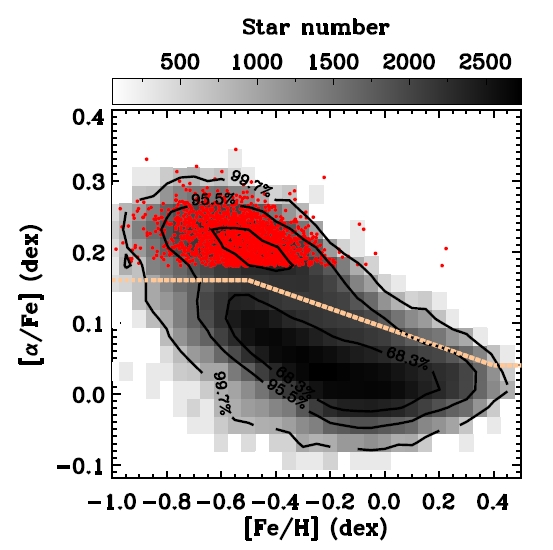You are here
LAMOST Data Reveals Alpha-rich "Young" Stars are Actually NOT Young
The alpha-rich giant stars with theoretical young ages have been treated as an abnormal population, since they cannot be understood in the canonical scheme of the Galactic chemical evolution. A new study by PhD student Meng Zhang, Prof. Huawei Zhang from Peking University and Dr. Maosheng Xiang from Max-Planck Institute for Astronomy has uncovered the nature of these stellar anomalies. The results have been published in The Astrophysical Journal.
Recent observations have revealed a population of alpha-element enhanced giant stars with unexpected high masses. Assuming single-star evolution, their masses imply young ages. However, in the context of the Galactic chemical evolution, stars formed at early epochs are enhanced in alpha-elements. So alpha-rich stars are generally believed to be old.
Several scenarios have been proposed to explain the origins of these alpha-rich "young" stars. Some try to use special Galactic chemo-dynamic events, for instance, star formation events near the edge of the Galactic bar; and some attribute to binary evolution.

Figure 1: The alpha-rich "young" sample stars (red dots) in the [Fe/H]–[alpha/Fe] plane. (Credit: Meng Zhang)
In this work, taking advantage of the large sample of stars from LAMOST spectroscopic surveys, the researchers found more than 1000 alpha-rich "young" stars (Fig.1). Combined with the astrometric data provided by the Gaia satellite, their chemistry and kinematics were studied in detail. The researchers found that these stars share the same kinematics as the canonical alpha-rich old stars, however, their chemical properties are different from the old stars. The alpha-rich "young" stars have typically more carbon and nitrogen, and the content of barium is significantly high in about 15% of these stars, compared to most of those old stars. It could not be explained by their single-star evolution, so external sources of these extra elements are needed.
Considering the element barium is mostly produced by asymptotic giant branch (AGB) stars who have evolved to the late stage of their life, AGB stars naturally become the candidate donors. This can be achieved if they are in a binary system, namely an alpha-rich "young" star can "eat" the materials with rich carbon and barium from its AGB companion (Fig. 2).

Figure 2: The mass transfer between binary stars. (Credit: Meng Zhang)
"When the single stellar evolution is considered, these stars look young, because they are massive. However, our results support the previous suggestion that these stellar anomalies are products of binary evolution. Their high mass is the result of accreting materials from their companions in the binary systems," said Meng Zhang, the first author of the research paper. "Our study confirms that most, if not all, alpha-rich stars in the Galactic disk seem to be old."
It is the first time to study the chemistry and kinematics of the alpha-rich massive stars using such a large sample. With the LAMOST spectroscopic survey, people can study stellar anomalies systematically, and gain more understanding about the stellar evolution and the Milky Way assembling history.
The paper can be accessed at https://iopscience.iop.org/article/10.3847/1538-4357/ac22a5.
